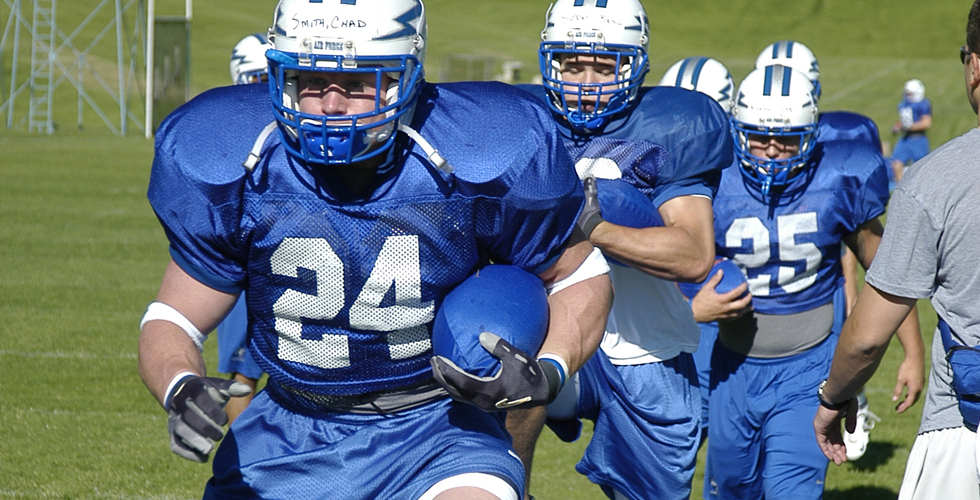A Computer Model for Football Play Calling

(Inside Science) -- Football coaches are famous for their dedication to winning. Video studies of upcoming opponents begin so early in the morning that most people are still dreaming about their first cup of coffee; strategy sessions run past the time insomniacs fall asleep.
But a new computer model may be able to take the play calling load off of the coach and, through fast, real-time analysis of all the offensive and defensive possibilities, dictate the best play to call in any game situation. The program takes the human element out of play calling and instead uses mathematical and statistical techniques.
Operations researcher Sharif Melouk and applied statistician Marcus Perry, both from the University of Alabama in Tuscaloosa, collaborated with a graduate student to apply techniques often used to allocate resources in contexts like business and antiterrorist protection efforts to football play calling. "We're at Alabama, we're pretty serious about football here," said Melouk.
"We're avid sports fans ourselves, so we like to look at the quantitative side of the analysis as opposed to the subjective analysis you might get, say on ESPN," said Perry.
Their model analyzes what the opposing team is likely to do and chooses the play that will best counter it in a given game situation.
"The offense knows all the different sorts of plays they could call for a particular situation, and they're also going to know what all the different types of defenses that the defense could throw at them," said Melouk. "The end result of the procedure is that you come out with some reward or some value to that particular play."
If coaches can enter accurate data into the model, then it will be effective. The better the data, the better the performance of the model will be. Removing the human element from play calling may improve the team's performance, or at least provide a basis from which to compare and analyze play calling.
The traditional method of calling plays is based on the tendencies of the opposing team as well as the strengths and weaknesses of the individual players. If an offense knows that a defense always sends its middle linebacker to rush the quarterback on third downs, then they can call plays to exploit that tendency. Or if the right defensive end is not effective against running plays, then that will lead the offense to run to that side.
Teams will often know their weaknesses, and attempt to correct for them, which is where this dance of play callers becomes complicated. Depending on the game situation (down, distance, field position, game score and time remaining), the offense generally wants to select a play that will produce the largest expected minimum gain.
In a third down situation with 3-yards to go, the offense would love to be able to pick a play that will give them the gain of 3-yards no matter what the defense decides to do. In turn, the defense would like to pick a play that limits any gains to 2-yards or less, regardless of which offensive play is called. It isn't always this simple, but it is an interactive game within the game.
Another example is what can happen if an offense adds a great running back. The obvious consequence would be that the offense would choose to run the ball more often. However, the defense knows about the running back, and if it reacts by protecting against the run more often, then the offense must recognize this change which might lead them to increase the frequency of pass plays.
These examples illustrate the calculations that enter into Melouk and Perry's model. It uses concepts developed from areas of research called game theory, linear programming, and utility theory. Together, these methods help a team pick the optimal play to call against its opponent, given the game situation.
One interesting feature of the model is that it can reveal what both teams should do, which is called the Nash equilibrium, after the Nobel laureate John Nash, who was the inspiration for the film "A Beautiful Mind."
"Basically player two [the defense] is looking to minimize the maximum gain of player one [the offense], and player one is looking to maximize the minimum gain of player two," said Melouk. "There's one point that tells you each of these players should do this one thing and they shouldn't deviate from this particular strategy."
When there are two players in a game where both are attempting to stop the other one, sometimes it's best to seek guaranteed modest gains instead of doing something risky. "If we knew what play, however, that the opponent was going to choose, then we could maximize our gain," said Perry. "But we might be able to choose a play … such that, hey, it doesn't matter what they choose. We're still going to get this particular level of gain regardless."
There's no reason to expect that computers will replace head coaches, however. Models are only as good as the information used to construct them. Filling a computer program with the correct underlying data could itself require a massive amount of work, and then coaches would certainly worry about its accuracy and update it incessantly. Teams may deviate from the model because of a hunch, to attempt a trick play, or to set up something they plan to try later in the game.
One thing that computers are good at is processing large amounts of data, which would allow them to analyze the hundreds of possible plays in a team's playbook in the limited amount of time between downs.
"The time to solve and come up with answers is negligible, really, especially with computers," said Melouk.
It has always been easy for fans to moan when they think a coach called the wrong play at a critical moment in a game -- and the model can determine if the fans are justified by showing the difference between the chosen play, and the optimum play.
The researchers feel like their model can be a useful tool to football coaches, but don't expect it to replace decades of experience. "You'll probably go with your instincts in a high pressure situation," said Perry. "I personally would go with my experience over some model where all these assumptions have been made that may not be true."
Melouk and Perry's company, PM Consulting, is trying to put their model into the field and see how it holds up in game situation.
"It's another layer of information that folks can use pre-game, during game, [and] post-game," Melouk said.

